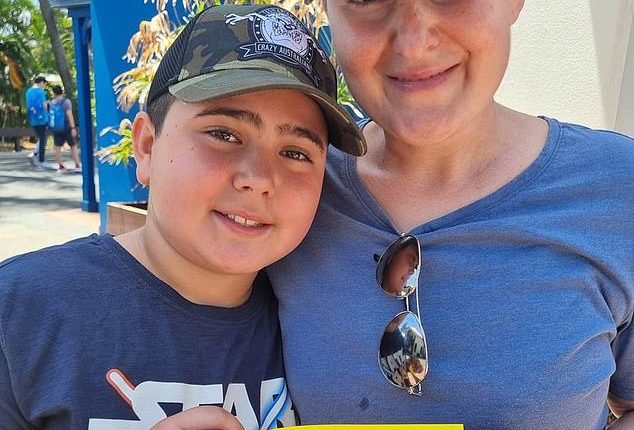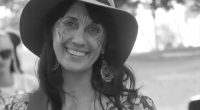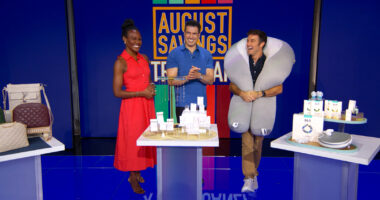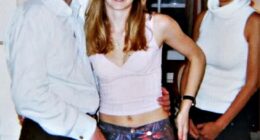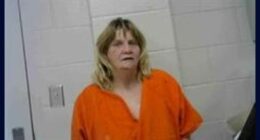A two-year investigation into the deadly Sea World helicopter crash has blamed the accident on a radio fault which prevented a crucial call being made, and limitations in sight lines to see nearby aircraft.
Four people died and nine more were injured when two helicopters collided mid-air on the Gold Coast Broadwater in January 2023.
The Australian Transport Safety Bureau published its final report into the crash on Wednesday, more than two years after the collision.
The report stated that prior to the collision, an inbound call from the arriving helicopter was not received by the second helicopter, which was loading passengers in preparation for departure.
Once passengers were loaded onto the aircraft, a ground crew member advised the pilot that the airspace was clear and it was safe to depart.
‘However, this advice was no longer accurate by the time the helicopter took off more than 20 seconds later, as the inbound helicopter was continuing its approach to land,’ ATSB Chief Commissioner Angus Mitchell said.
‘In addition, restrictions on manoeuvring at the park pad, and the angles of closure of the two helicopters, limited the visibility for the departing pilot to identify the approaching helicopter.’
The first helicopter waited for a call from the second helicopter to separate to avoid a mid-air collision or if conditions changed, but that call never came.

Vanessa Tadros was killed in the crash while her son Nicholas was severely injured and had his right leg amputated (pictured, mother and son with their Sea World helicopter ticket)

Two helicopters collided mid-air on the Gold Coast Broadwater in January 2023 (pictured)

Sydney mother Vanessa Tadros, 36, died in the crash (pictured)
The report said the departing pilot made the ‘taxi’ call but it was not broadcast due to a fault in the antenna which allowed it to receive calls but not deliver them.
Without the radio calls, neither pilot had sufficient information to be able to locate the other helicopter.
‘Neither pilot was aware of the existence of faults in the radio of VH-XKQ that likely prevented broadcast of the taxi call,’ the report said.
‘This was such a profoundly unnecessary loss of life which must be prosecuted fully to ensure it never happens again.’
Pilot Ashley Jenkinson, 40, British couple Ron and Diane Hughes, 65 and 57, and Sydney mother Vanessa Tadros, 36, died in the crash.
Ms Tadros’ son Nicholas, 10, underwent serious surgeries following the crash while Victorian mum Winnie de Silva, 33, and her nine-year-old son Leon were hospitalised.
The pilot of the second chopper, Michael James, managed to land his damaged aircraft safely, but he and two of his passengers were injured by flying glass when its windshield shattered.

An interim report released a year after the crash revealed that a toxicology report for pilot Ashley Jenkinson, who died in the crash, had traces of cocaine in his system (pictured)
The report also found Sea World Helicopter’s system of radio calls, hand signals and conspicuity devices, intended to warn of the presence of another helicopter, was flawed.
This meant that both of the pilots formed an incorrect understanding about the location of the other helicopter.
The ATSB also found evidence that passengers on both of the helicopters were incorrectly restrained but could not determine how much that contributed to the injuries and deaths.
Investigators said the helicopters were changed a week before the crash and the new aircraft lacked company radio communications, had no mandate to make proactive calls, no live traffic displays, and the pilots were not familiar with the systems.
The report said the change in the positioning of the helipads a year before the crash also contributed to the lack of ability to see surrounding aircraft.
Shine Lawyers, who represent several people injured in the crash and those traumatised by what they witnessed, have been keenly awaiting the report.

British couple Diane and Ron Hughes died in the tragic crash (pictured at their wedding)

The Australian Transport Safety Bureau will hand down its final report into the crash on Wednesday, more than two years after the collision
‘This was a completely avoidable tragedy which has had a devastating impact on so many lives,’ litigation specialist Roger Singh said on Tuesday.
Claims have been made against Sea World Helicopters of up to $925,000 per person and the release of the report will inform any further action, Mr Singh said.
‘We will examine the findings of this report with a view to identifying other potential defendants and further damages which may be sought,’ he said.
It has been a long wait for the families of the victims to see the final report, but some evidence of what caused the crash had already been revealed.
An interim report released a year after the crash revealed that a toxicology report for pilot Ashley Jenkinson, who died in the crash, showed he had traces of cocaine in his system.
However the safety bureau noted the residual amount in his system was not enough to have impaired the pilot’s skills.
A preliminary report released in March 2023 found the other pilot, Mr James, saw six passengers boarding the second helicopter as he was coming in to land with five people on board at another helipad.
Mr James thought the second helicopter would pass behind his aircraft and did not remember the other pilot radioing him to say he was taking off.
A third helicopter pilot in the area recalled Mr James’ inbound call but did not remember hearing a taxi call from the other pilot while a fourth pilot also couldn’t remember hearing calls from either of the helicopters before the crash.
